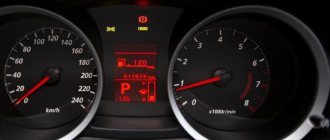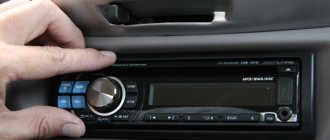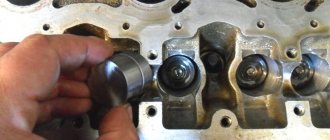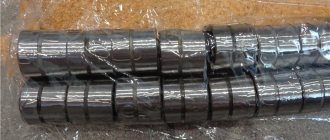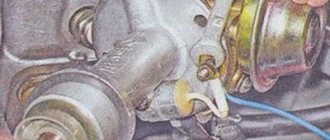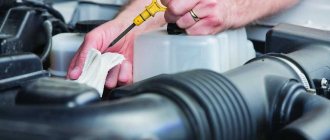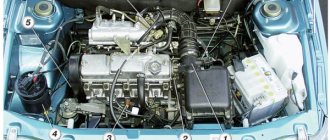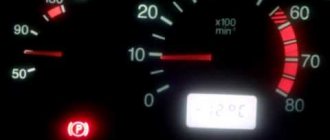string(10) “error stat” string(10) “error stat”
Diesel is the second most popular internal combustion engine. Its widespread use is primarily due to its cost-effectiveness. However, problems often arise when servicing the power unit. One of them is poor starting in the cold season. The reason why a diesel engine has trouble starting can be either poor fuel or a malfunction of various systems and components. Let's take a closer look at why this happens and what causes it.
Winter…
Features of diesel engine operation
In gasoline units, a mixture of air and fuel is formed, which is injected into the cylinders using an injector. Once in the combustion chamber, the mixture is ignited by a spark plug and a working stroke occurs. Next – release, compression, then the cycle repeats. Unlike gasoline engines, in a diesel engine the mixture is ignited by high pressure. It will enter the combustion chamber using spray nozzles. In addition, the glow plug is switched on, which heats the fuel to the required temperatures.
But if they fail, the diesel unit is unable to start normally. The glow plug significantly simplifies the process of igniting the fuel and, accordingly, starting the engine. If the diesel engine does not, then the control relay is broken and the spark plug does not heat up the diesel fuel. The action of this element does not stop until the coolant temperature reaches operating values. The glow plug often saved car owners when starting the engine in winter.
We also note that, in addition to the ignition method, such engines differ in the design of the fuel system. And if gasoline ones have a simple submersible pump, here there are two of them: one of low pressure and the other of high pressure. Well, let's look at why diesel is not “hot”.
Diesel stalls when cold
The reasons why a diesel engine starts poorly when cold, including the engine stalling quickly after starting, are:
- Using summer diesel fuel . Diesel fuel used in the warm season has a larger amount of paraffin, which thickens in cold weather and clogs the fuel system, including the fuel filter. Accordingly, fuel cannot pass through it, which causes fuel starvation of the engine and it simply stalls a few seconds after starting.
- Incorrectly set ignition . In cold air, ignition angle is critical because it is better for the fuel to enter the engine when there is already a high compression ratio present. In the case of an electronic control system, this problem is irrelevant, since everything is controlled electronically. There may also be an option when the injection is out of sync with the operation of the high-pressure pump due to the fact that the timing belt has jumped one tooth. Accordingly, the belt needs to be checked.
- The fuel heater does not work . This device is not installed on all cars, but mainly on new ones or those that are used in cold regions. The preheater operates on the basis of thermal electric heaters (TEHs), and turns on at a temperature of +5°C...+10°C (the corresponding value may vary for each car manufacturer). When the diesel fuel warms up enough, the heater turns off accordingly. If the heater is not working, the engine may operate unstably and stall when cold. Also, the reason for this may not be the heater itself, but a temperature sensor, which provides information about the temperature of the fuel, and, accordingly, the moment when the heater is turned on/off. Therefore, when diagnosing, you need to check the heater control system, the condition of its electric heaters, as well as the temperature sensor.
- Using summer motor oil . Oils with low viscosity quickly thicken in the cold, and accordingly, it is difficult for the starter and engine (pump) to pump it through the main line. Therefore, during the warm-up process (even if the car starts), the car may simply stall when idling.
Compression
Initially, its level is two times higher than that of gasoline units. The mixture ignites under strong compression. And a drop in compression does not have the best effect on starting the engine. Since any compression process is accompanied by the release of thermal energy, the mixture does not heat up enough and is not able to ignite. If it is a car with high mileage, compression drops when the cylinder walls wear out and the rings burn out. Recall that each piston has three rings. Two are compression, one is oil scraper. This requires disassembly and repair of the engine. It happens that compression drops in only one of the cylinders. In this case, the diesel engine starts and stalls or troits. This means that one of the cylinders is not working or ignition occurs irregularly.
Bacteriological factor
Unlike gasoline, diesel fuel is a fertile environment for the proliferation of microorganisms and bacteria. This is especially often observed when water gets into the tank - an ideal environment for reproduction. The rapid growth of bacteria causes the appearance of mucus, acids and other potentially dangerous substances that stick together the fuel pump, filters, and injectors. The process is accompanied by abundant formation and release of hydrogen sulfide, so the fuel in the tank has a persistent unpleasant smell of rotten eggs. As the temperature rises, the process of reproduction of microorganisms only intensifies, but the problem is sometimes typical in frosty weather.
To get rid of unwanted guests, it is recommended to completely drain and clean the fuel tank. For this purpose, special additives are used - biocides. A fresh and cleaned tank is treated with biocides for preventive purposes, after which fuel can be poured into it. Fuel wires and the pump are also cleaned if they are dirty.
What is normal compression?
If for gasoline units this figure is from 9 kg/cm², then for diesel units the minimum value is 23 kg/cm². It is measured using a special device - a compression meter.
In this case, the starter must be turned for no more than 3-4 seconds, otherwise the battery will discharge. Already at the first “grabbing” the result will be visible. It will not change with further rotation of the crankshaft.
Diesel exhaust color
Analyzing the color of diesel exhaust may indicate part of the problem. If a diesel engine produces bluish smoke, this indicates that the fuel does not burn quickly. Blue diesel exhaust is caused by fuel evaporating in the exhaust system from contact with heated parts. In the cylinders themselves, it is not possible to completely and evenly burn the mixture of diesel fuel and air.
It is worth noting that during the warm-up process of a diesel engine, white or bluish exhaust is allowed. After the diesel engine reaches operating temperature, this exhaust color indirectly indicates:
- low diesel compression;
- problems with fuel injection pump or injectors;
- late injection advance angle;
- possible malfunction of glow plugs;
- failure of the relay or glow plug control unit;
Black diesel exhaust indicates that the injectors are overfilling with fuel. The second reason why a diesel engine smokes black smoke is insufficient air supply to the cylinders. This indicates problems in the air supply system, and the cause is severe contamination of the diesel engine air filter.
Glow plugs
Why won't the diesel start? The reasons may be hidden in the glow plugs. It is very simple to determine this breakdown - the car starts well only with a warm engine. “When cold,” the starter turns, but the engine does not start due to the unheated combustion chamber. Usually happens in winter.
Also, if the engine was able to start, it will work intermittently. If the diesel engine is bad, several glow plugs may have failed at once.
Hot engine failures
The reasons why a diesel engine does not start when hot are not as varied as those with carburetor power units. More than 70% of cases of difficulty starting a warm diesel engine occur due to problems in the fuel system, which consists of the following devices:
- air purifier;
- hand pump (this applies to old diesel engines);
- nozzles, sprayers;
- injection pump;
- fine filters, pre-cleaning of diesel fuel;
- crankshaft speed regulator;
- fuel drive.
In a constantly running diesel engine, the production of injectors, plungers, and sprayers occurs. Over time, springs lose their elasticity. Due to aging and exposure to high temperatures, rubber seals and sealing cuffs become less elastic, the density and tightness are impaired. Fuel lines become clogged due to poor quality fuel. This entails problems with the entire system.
We recommend: Kubota is a masterpiece of design thought.
Failure of factory regulation, uniform supply of precise volumes of mixture, advance angles, initial pressure of rising needles in injectors, and lowest crankshaft speeds at idle leads to an increase in diesel fuel consumption and constant smoke in exhaust gases. Often, difficult starting of a warm diesel engine occurs due to the following accompanying factors:
- low pressure in the fuel supply lines;
- The operation of the crankshaft position and air flow sensors is disrupted.
Diesel malfunctions visible from the outside and methods for eliminating them are shown in the table:
Filters
For what other reasons does a diesel engine not start? Of course, these are filters. It is necessary to check their condition.
There are two levels of purification in the fuel system of a diesel engine - coarse and fine.
The latter needs to be given special attention. The paper cavity of the filter, through which fuel passes to the nozzles, is capable of trapping particles up to 10 microns in size. The resource of this element is 8-10 thousand kilometers. If you do not follow these regulations, the filter will simply become clogged. As a result, fuel will not flow into the combustion chamber, although the pump produces the required pressure. This can be determined by the nature of the vehicle's movement. If there are dips in dynamics, this means that fuel is supplied with a delay. And it is the filter clogged with dirt that delays it. It is worth mentioning the air elements.
Such filters also require replacement. According to regulations, their service life is 10 thousand kilometers.
They are stored in a plastic case; you can replace them yourself by sliding the mounting brackets and removing the cover. The photo above shows what a dirty air filter looks like. Because of this, the diesel engine will not start. The oxygen supply stops or is reduced to a minimum level. The engine does not have enough air - it choke on fuel.
How to start a diesel engine in cold weather
In order to start a diesel engine at subzero temperatures, it is necessary to approach this procedure comprehensively and perform the following actions:
- As soon as it gets significantly colder outside, it is necessary to fill the fuel tank with winter diesel fuel . If the nearest gas stations have not yet switched to it, then you can add anti-gels or kerosene (preferred) or gasoline (95 or 98) to your summer diesel fuel. The amount of antigel is indicated on the package. As for kerosene or gasoline, it is added 10% of the volume of the fuel tank, decreasing by every 10 degrees Celsius. Please note that you cannot add kerosene to diesel fuel if the car has a modern Common Rail control system.
- Using a clean fuel filter. to change the fuel filter with a new one before the onset of winter . This is especially true for engines with a Common Rail system, since their degree of filtration is higher and is designed for smaller honeycombs in the filter.
- Use motor oil for winter. When choosing, first of all, you need to take into account low-temperature viscosity so that the oil composition is more liquid and does not thicken in cold weather. High temperature viscosity must be taken into account according to the vehicle manufacturer's recommendations. Typically, the instructions indicate that oils of different viscosities can be poured into the engine, so you need to choose a more liquid one from the list. In this case, it is advisable to choose synthetic or semi-synthetic compounds (mineral ones can be used in the summer), since they have more stable performance characteristics and retain their lubricating and protective properties for a longer time.
- Before the onset of cold weather, it is advisable to inspect the fuel system for leaks. In particular, check the clamps and pipes to see if diesel fuel is leaking somewhere. It is advisable to install a transparent tube somewhere in one place in order to see if there are any air bubbles going through it.
- To prevent diesel fuel from draining back into the fuel tank, it is advisable to install a check valve or a small pump that creates a pressure of up to 0.5 atmospheres. With its help, diesel fuel is supplied to the engine without any problems, which makes it easier to start in any conditions. Sometimes, instead of an electric pump, a manual rubber bulb is installed. Modern Common Rail systems do not have this problem, since the pump is located in the fuel tank.
- Check the operation of the glow plugs . This can be done using different methods - without removing them from the engine, using a control light, battery or multimeter. If any spark plug begins to work poorly, it is better to replace it with a new one, preferably at the beginning of winter. In general, it is recommended to change glow plugs approximately once every two seasons, even if they are still in more or less working condition. The only exception may be the warranty period or the mileage of new spark plugs.
- Failure of the glow plug relay . In some cases, the output voltage at the glow plug relay is lower than required. This leads to the fact that these spark plugs do not operate at full capacity, and, accordingly, do not heat diesel fuel well. In addition, modern diesel engines contain “smart” electronics that allow the engine to start only when the diesel fuel reaches a certain temperature. It is easy to check the operation of the relay. To do this, it is enough to use a wire with a large cross-section (4 or 6 square millimeters) to apply voltage directly from the battery to the spark plugs. If the engine starts without problems, you need to change the relay for a new one or make some kind of “homemade” with a similar wire and a button in the cockpit (but with a relay it’s still better, since it’s both automation and protection).
- Low compression . Before the cold season, it is also worth checking the compression. This is done using a compression tester in a garage or using a compression tester or motor tester at service stations. The reasons for low compression may be the following engine elements - wear of piston group parts (piston, rings, cylinder), incorrect adjustment of timing mechanism elements, burnout of valves and/or pistons.
- Check the operation of the starter . It should produce normal (high) rpm. It is advisable to carry out a comprehensive check of both the mechanical and electrical parts (stator/rotor windings, bearings, brushes).
- Charge the battery . During the cold season, you should always monitor the battery charge level, especially if it has been in use for a long time. When the battery is old, it is better to choose the best battery for your car before winter sets in. When choosing, pay attention to the fact that a diesel engine requires a battery with a higher cold cranking current than a gasoline engine. For prevention, it is advisable to remove the battery at night and recharge it from a charger in the garage or at home once a month.
- Check the operation of the generator . Even if a new battery is installed on the car, it is important that it is charged at the normal voltage provided by the generator. That is, you need to check both the operation of the generator itself and check the voltage value supplied to the battery. Usually it is about 14.2...14.5 Volts. The lower the ambient temperature, the higher the voltage should be.
- Check ignition settings . The fact is that some cars work better when the angle is still small, that is, the compression ratio is small. Others, on the contrary, start better when the fuel is supplied with a significant level of compression. Information about this can be found in the vehicle documentation or contact a car service center for help.
- Check the operation of the injectors . Do it yourself in the garage or at home. If the injectors are clogged with deposits, they can also be cleaned in a garage. As a last resort, replace the injectors with new ones. In the latter case, it is better to replace them as a set so that the old injectors do not cause problems compared to the new ones. If the Common Rail injector is leaking, you should check the multi-check valve, or it is better to immediately replace it with a new one.
- Check the fuel heater (if equipped). They operate on the basis of electric heating elements, so you need to check whether electricity from the generator is suitable for them, whether they are intact, and also check the operation of the temperature sensor, which provides information to the electronic control unit about the temperature of the diesel fuel, and accordingly, a command is generated to turn the heater on/off.
When all the parts are more or less in working order, but difficulties arise when starting the diesel engine “cold”, then follow a few simple recommendations:
- During startup, be sure to press the accelerator pedal in order to supply more fuel to the engine. This is especially important during the cold season.
- Starting a diesel engine in winter is made easier by using an external fuel heater. If the standard design of the car does not provide for the installation of the specified heater, then you can install it yourself. Currently, there are three types of such heaters on sale - for the fuel filter, for oil and coolant.
- As a last resort, when the engine does not start, but you still need to drive, you can use the “quick start” tool. The aerosol is sprayed into the intake manifold, after which the probability of starting a diesel engine significantly increases (according to their manufacturers, the probability of starting is about 90%). However, it is necessary to understand that “quick start” products cannot be used on an ongoing basis, and it is not a panacea. That is, it is still necessary to find a breakdown in the engine if it exists and eliminate it.
Conclusion
If you have problems starting or running the engine “cold,” you first need to pay attention to the fuel used, the condition of the fuel filter, the battery charge level, and the viscosity of the engine oil used. Next, it makes sense to check the tightness of the fuel system (lack of air in it), the operation of the glow plugs and injectors. In general, the normal operation of a diesel engine is largely ensured by preventive actions and the use of winter diesel fuel.
Pump
There are two mechanisms in the system. These are fuel injection pump and high pressure fuel pump. Often the first element fails, since its structure is more complex than that of the second. The pump cannot produce the required pressure in the fuel system, which is why the diesel engine does not start or starts with difficulty. The movement is accompanied by “sneezing” (as if the car does not have enough fuel). It is worth noting that a belt is connected to the injection pump. It may tear or fly off. First of all, we check the belt drive. Check the fuel system fuses (which go to the pump). One of them may burn out. This often happens during a short circuit. Experienced motorists are advised to always carry a set of spare fuses in the glove compartment.
Low battery level or problems with the starter
A normally charged battery can cope with loads at any time of the year. But if the battery is old (more than three years old), problems cannot be avoided. The crankshaft will not rotate at the required frequency, which is why the required pressure in the system will not be created, and the glow plugs will not warm up to the required temperature.
A faulty starter is another reason for difficult starting. In this case, clicking and “buzzing” sounds will be heard when starting. All this suggests that the device needs to be replaced.
And one more thing about the battery: when choosing a battery, you need to take into account its starting current, which should be at least 320 amperes.
Fuel and winter
Diesel starts especially poorly in the autumn-winter period, when the air temperature drops sharply and “Arctic” fuel has not yet appeared at gas stations. As a result, the summer diesel fuel simply freezes. At low temperatures, it crystallizes and turns into paraffin, which becomes clogged in fuel lines and filters.
Further movement with such a filter as in the photo above is simply impossible. Some cars have filter heating installed. But it only saves at startup. After a couple of seconds the car stalls again. It is very difficult to heat up an entire tank with frozen fuel. Not all cars have a preheater. What is the difference between summer and winter fuel? There are additives that reduce the waxing threshold at low temperatures. To prevent the problem from taking you by surprise, purchase a diesel fuel additive before the onset of cold weather. Experienced motorists recommend not leaving your car in a parking lot with a half-empty tank. Overnight, the liquid condenses and water forms on the walls. It also does not have the best effect on engine starting. In winter, try to maintain the level above half. Moreover, driving on an empty tank often kills the pump. This applies not only to diesel, but also to gasoline cars.
Water got into the filter and froze
Another reason why the fuel is not pumped is that water got into it and froze in the filter.
Depending on the design, the fuel filter is maintenance-free (i.e. it must be replaced every 30,000 km) or has a water drain. How much water accumulates in the filter depends on the quality of the fuel, ambient temperature, number of engine cranks, etc. If you do not drain the fuel filter from time to time, severe frost may cause an ice plug to completely block the flow. diesel fuel into the engine. It's worth checking: if the filter in your car has a drain plug, it's worth using it from time to time. In addition, do not delay replacing the fuel filter.
For prevention, you need to keep the tank as full as possible in winter, use winter diesel fuel or add a dehydrogenating additive. Also, many diesel engines have a special drain plug near the fuel filter, which should be used to drain water that accumulates from time to time. It's worth finding out if there is such an element under the hood.
Starter
This problem occurs on both petrol and diesel cars. A relay is also connected to it.
And if the starter does not turn, we listen for clicks, as is the case with the glow plug relay. Perhaps it's an open circuit. Check the battery charge. Of course, it won't be able to drop to such a low level overnight. Even at eight volts it will turn the starter. Slowly, but still. A sharp decrease in level occurs in the event of a short circuit to ground. Perhaps the contact has broken and is shorting out.
Causes of problems - engine wear
In some situations, breakdown of a diesel engine may be caused by wear of the unit or parts of the fuel system.
This provokes a decrease in compression and the engine will either start poorly or not be able to work at all. This is especially noticeable in the cold season, even if the spark plugs are fully operational and the driver uses only high-quality winter fuel. Quite often, the engine is started from a tug and if it is warmed up, it does not cause problems. It is worth noting that a sharp decrease in compression indicates wear of the unit. Then it must be repaired or replaced. You can also understand that the engine is worn out if the fuel oil consumption is increased and the pressure in the crankcase is quite high. In this situation, the only way out is a major engine overhaul.
In addition, the nozzle nozzles may become unusable, which will increase the consumption of diesel fuel, and black smoke will come out of the exhaust pipe. Very rarely, when nozzles break down, you can see acrid white smoke from the exhaust. These parts should be changed in a timely manner, since their service life is about eighty thousand kilometers.
A long period of engine operation with worn nozzles can lead to burnout of the pistons and pre-chambers. Quite often you can encounter situations where the injection pump plunger pairs wear out, which is accompanied by difficulty starting a heated engine. They also need to be changed periodically to avoid motor damage.
Timing belt
Why won't the diesel engine start yet? If the battery is well charged, the starter turns, but does not “grab”, the timing belt may have broken. The system is not able to select the correct phase for each cylinder. Often on 16-valve engines, this failure is accompanied by deformation of the intake and exhaust valves. They bend when the piston hits.
To avoid letting your car get into this state, check the serviceability of the belt. If there are tears or cracks, it must be replaced. Buy original spare parts. The belt is a very important part in a car. According to the regulations, it changes every 70 thousand kilometers. If it is a chain drive, the element may simply stretch or skew one or more teeth. Manufacturers say that the chain in the engine is designed to last the entire life of the engine. But after 200 thousand it stretches - noises are heard during operation. With such symptoms, you need to change it urgently.
Quality of diesel engine oil
Lower outside temperatures often cause diesel engines to have difficulty starting in winter. The reason may be that the oil in the diesel crankcase is thick. Diesel engines are often operated on 15W-40 motor oil. At low temperatures, this viscosity indicator can make it difficult to start a diesel engine.
To check, just pull out the oil dipstick and assess the condition of the engine oil after the diesel car has been parked in the cold. The oil on the dipstick should show signs of fluidity. Otherwise, and there is obvious solidification of the oil, it is advisable to switch to a synthetic motor oil with a lower viscosity recommended for a particular engine.
Diesel won't start
A diesel engine that cranks normally but does not start regardless of outside temperature either has low compression or has a fuel delivery problem. If compression is OK, check the fuel gauges. Next, check the fuel filters and fuel lines for blockages.
If the fuel pump is not pushing fuel through the lines to the injectors, this may indicate a faulty solenoid. Listen for a "clicking" sound inside the pump when the ignition key is turned on. No clicking noise means the pump and/or solenoid needs to be replaced. If it clicks but there is no fuel flowing through the injector tubes (and the filter and lines are not blocked), the pump is likely bad and needs to be replaced.
Club of fans of minibuses and minivans
At high temperatures outside or when the engine is hot, a serviceable diesel engine can be started without glow plugs at all. In severe frost, the purpose of the pre-heating system is not only to facilitate starting, but also to help during the first seconds of warming up. After the “spiral” on the dashboard has died down, the spark plugs continue to work for some time. If you managed to start the internal combustion engine on a frosty morning, albeit off the air, but the engine continues to run unstably for some time, be sure to pay attention to diagnosing the glow plugs.
How to check
- The candle must be turned out of the well;
- connect it directly from the battery (ground to the spark plug body, plus to the bus connection point) and watch it warm up. A working candle necessarily glows from the edge, uniformly changing color as it heats up.
Only such a system will ensure proper starting in cold weather.
Why is diesel difficult to start?
The system includes:
- glow plugs;
- heating relay;
- a bus that connects all spark plugs into a single circuit.
The check should begin with the glow plugs. I can assure you that the popular test method of measuring resistance with a multimeter is a largely ineffective test.
It is designed to detect a rupture of the heating element (in this case there will be no resistance). All spark plugs may have resistance, but they will be the reason for poor starting in cold winter.
Two-mass flywheel
Installed (in the vast majority) on diesel engines. Its task is to dampen vibration in the crank-piston system. The dual-mass flywheel not only improves driving comfort, but above all reduces the load on the gearbox and also allows for a lower idling speed (reduced CO2 emissions). In some cars, two-mass wheels can withstand a quarter of a million kilometers, and in others up to 100 thousand kilometers. The shelf life is reduced by city driving (low speeds, frequent starts).
Symptoms of a diesel engine malfunction:
- jerking when idling
- knocking when turning off the engine and creaking when decreasing gears.
Strength Wheel Replacement: The used flywheel should be replaced with a new one. Usually, by the way, a new clutch is also installed.
Diesel models:
- FORD MONDEO III 2.0 TDCI is an extremely fragile engine.
- MAZDA 6 2.0 CD - lags behind other Japanese cars in terms of wheel strength.
- The PEUGEOT 406 1.6 HDI is a heavy car with a weak two-piece flywheel.
Causes of poor diesel starting
- Why is it difficult to start when the injector is cold?
- Why is it difficult to start on a cold carburetor?
- Why is it difficult to start on a cold diesel engine?
Reasons why it is difficult to start when cold It is important to distinguish between situations in which problems arise: the car is hot and difficult to start, difficult to start after being idle, when it cools down, (especially in the morning) if it refuses to start in cold weather. They all have their own nuances and reasons that should be considered separately.
We will understand in general terms what reasons lead specifically to poor starting of a cold engine. Usually one or two rotations of the starter armature shaft are enough to start a car in good condition.
If this cannot be done, you need to look for why.
The fuel is not quite winter friendly
Diesel fuel that does not meet official winter standards will not allow you to start the engine in the morning after overnight frosts. If paraffin precipitates, the fuel filter or line will clog and the fuel supply will stop.
To avoid troubles, you need to refuel with high-quality winter fuel at proven gas stations. If doubts remain, then it is better to use a special fuel additive and preferably before the onset of frost.
